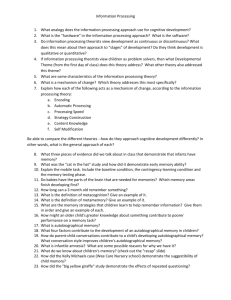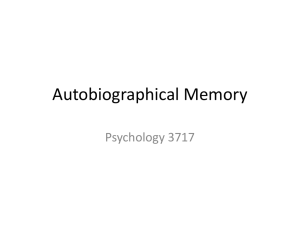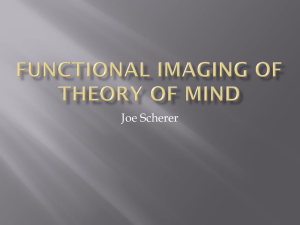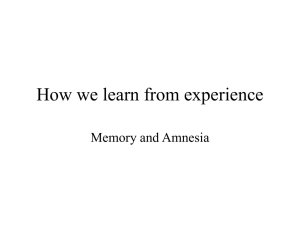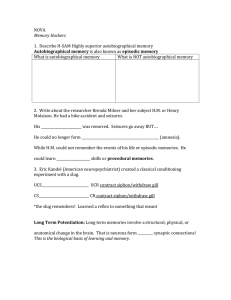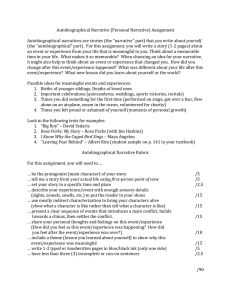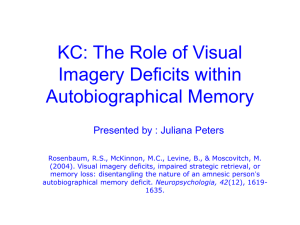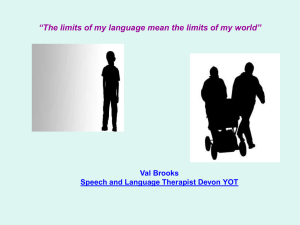M.S.: a case of autobiographical amnesia and visual memory loss
advertisement
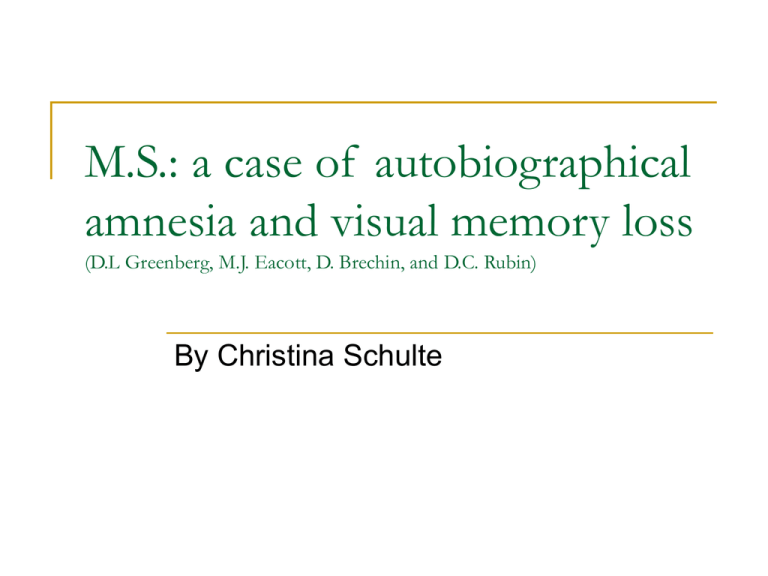
M.S.: a case of autobiographical amnesia and visual memory loss (D.L Greenberg, M.J. Eacott, D. Brechin, and D.C. Rubin) By Christina Schulte M.S. is a 60 year old, left-handed, British male. He works at a REMPLOY factory and is semi-independent. He scores average on WAIS for verbal IQ (101) and above average mental arithmetic on WAIS-R (14). While a 23 year old police cadet in 1970 he was diagnosed with herpes encephalitis. Neuroimaging shows extensive damage to the occipital and temporal lobes and some damage to right parietal lobe. Specific Mental Functionality Abnormalities: Associative visual agnosia Prosopagnosia Achromatopsia Visual-memory-deficit amnesia (VMDA) Retrograde amnesia Anterograde amnesia He does have: Normal visual acuity Normal linguistic abilities Near normal semantic memory, including personal semantic knowledge, (although the author’s note he may have some deficits, especially with items belonging to living categories.) Normal executive functioning Specifically Right side Left side Temporal: temporal pole, para-hippocampal gyrus, hippocampus, amygdala, & 4th temporal gyrus damaged. Occipital: cortex spared but infra- & suprcalcarine regions are abnormal. Temporal: temporal pole, 2nd, 3rd, 4th temporal gyri, anterior parahippocampal gyrus damaged. Amydgala & hippocampus spared. Occipitial: cortex and occipitotemporal junction destroyed Parietal: white matter destroyed but cortex intact Tests of Mental Imagery Top: M.S.’s copy of a rhinoceros (Graded Naming task). He later failed to recognize the object he had drawn. Bottom: Attempts to draw items from memory. Tree, bird, butterfly, car. His performance on object recognition tested by the Category-Specific Names Test was equally poor. He recognized 0/30 fruits and 0/30 animals. In a spontaneous naming test he could only name 16 out of 30 household objects. He recognizes non-living items much better than living items. In name recognition, he is almost at normal levels, but he is poor at face recognition due to his prosopagnosia. Previous studies revealed that he searches individual characteristics of the face and cannot see it as a whole. Tests of Autobiographical Memory Table 1 MS's performance on the autobiographical memory interview Childhood Pre-illness Post-illness Recent Semantic: 15 (16–21) 14 (17–21) 16 (17–21) 18.5 (19–21) Autobio- : 1 (6–9) 4 (7–9) 3 (7–9) 2 (7-9) Graphical (normal range listed in parenthesis) He was assesed by a large number of autobiographical memory tests over the course of 3+ years When cued with keywords tailored to his past he performed way below controls. He recalled 31 memories (mostly anterograde) for 48 words when asked to recall memories from anytime in his life and 17/81 when asked to restrict his memories to retrograde. Overall, his results show ‘a severe and global autobiographical deficit.’ Discussion The authors’ believe that M.S.’s deficits qualify as an impaired access to long term visual memories because: he can copy an image and not recognize it, has difficulty recognizing common objects and drawing them from memory, and he has trouble manipulating visual images, particularly when they involve color, people or mental rotation. The authors further pose that this impairment has contributed to his loss of autobiographical knowledge. The loss of his visual regions may disrupt the activation for Autobiographical retrieval. He relies on other forms of memory, like semantic personal memory, to retrieve information about the past, but cannot recall specific episodes. M.S.’s outlook is fair, his cognitive functions have not declined or improved over time. The paper does not discuss the pursuit of any treatment options. What is not known is why his RA is different from other patients with Medial Temporal Lobe damage. His autobiographical memory is impaired across all periods of his lifetime, while others usually have poorer performance for recent past memories, and better retrieval for older memories.
